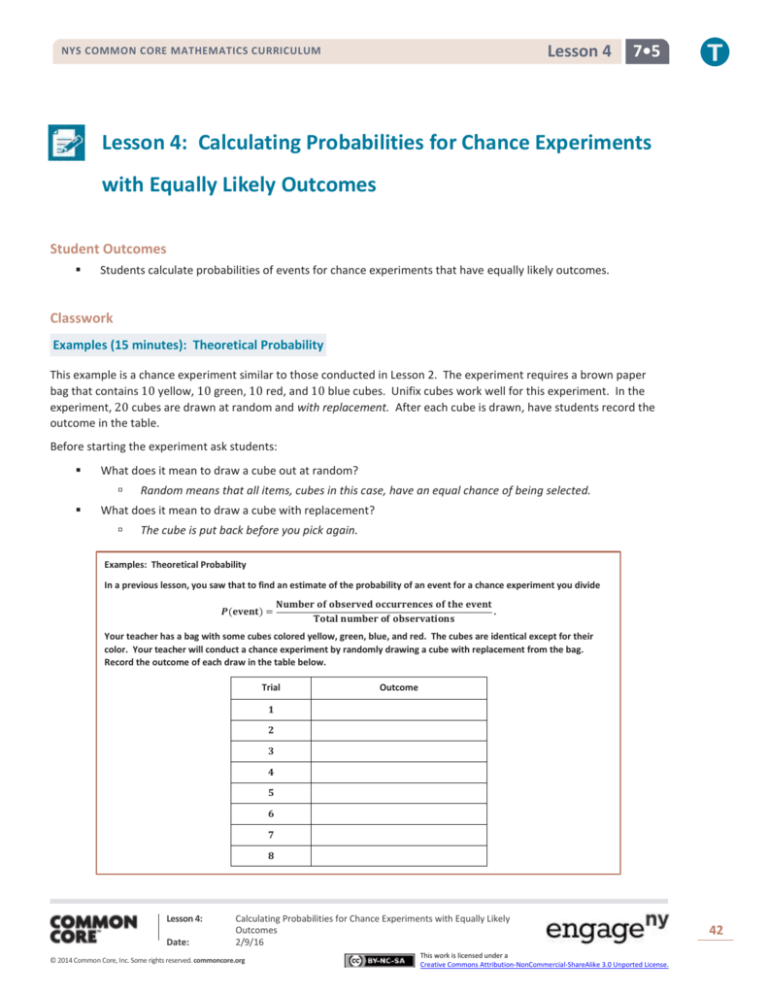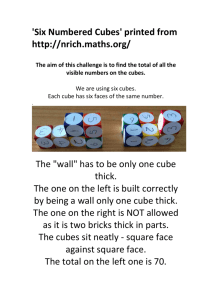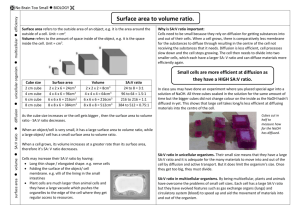
Lesson 4
NYS COMMON CORE MATHEMATICS CURRICULUM
7•5
Lesson 4: Calculating Probabilities for Chance Experiments
with Equally Likely Outcomes
Student Outcomes
Students calculate probabilities of events for chance experiments that have equally likely outcomes.
Classwork
Examples (15 minutes): Theoretical Probability
This example is a chance experiment similar to those conducted in Lesson 2. The experiment requires a brown paper
bag that contains 10 yellow, 10 green, 10 red, and 10 blue cubes. Unifix cubes work well for this experiment. In the
experiment, 20 cubes are drawn at random and with replacement. After each cube is drawn, have students record the
outcome in the table.
Before starting the experiment ask students:
What does it mean to draw a cube out at random?
Random means that all items, cubes in this case, have an equal chance of being selected.
What does it mean to draw a cube with replacement?
The cube is put back before you pick again.
Examples: Theoretical Probability
In a previous lesson, you saw that to find an estimate of the probability of an event for a chance experiment you divide
𝑷(𝐞𝐯𝐞𝐧𝐭) =
𝐍𝐮𝐦𝐛𝐞𝐫 𝐨𝐟 𝐨𝐛𝐬𝐞𝐫𝐯𝐞𝐝 𝐨𝐜𝐜𝐮𝐫𝐫𝐞𝐧𝐜𝐞𝐬 𝐨𝐟 𝐭𝐡𝐞 𝐞𝐯𝐞𝐧𝐭
.
𝐓𝐨𝐭𝐚𝐥 𝐧𝐮𝐦𝐛𝐞𝐫 𝐨𝐟 𝐨𝐛𝐬𝐞𝐫𝐯𝐚𝐭𝐢𝐨𝐧𝐬
Your teacher has a bag with some cubes colored yellow, green, blue, and red. The cubes are identical except for their
color. Your teacher will conduct a chance experiment by randomly drawing a cube with replacement from the bag.
Record the outcome of each draw in the table below.
Trial
Outcome
𝟏
𝟐
𝟑
𝟒
𝟓
𝟔
𝟕
𝟖
Lesson 4:
Date:
Calculating Probabilities for Chance Experiments with Equally Likely
Outcomes
2/9/16
© 2014 Common Core, Inc. Some rights reserved. commoncore.org
This work is licensed under a
Creative Commons Attribution-NonCommercial-ShareAlike 3.0 Unported License.
42
Lesson 4
NYS COMMON CORE MATHEMATICS CURRICULUM
7•5
𝟗
𝟏𝟎
𝟏𝟏
𝟏𝟐
𝟏𝟑
𝟏𝟒
𝟏𝟓
𝟏𝟔
𝟏𝟕
𝟏𝟖
𝟏𝟗
𝟐𝟎
Allow students to work with their partners on Examples 1–3. After students have completed the three questions, discuss
the answers.
1.
Based on the 𝟐𝟎 trials, estimate for the probability of
a.
choosing a yellow cube.
Answers will vary but should be approximately
b.
.
𝟒
𝟓
𝟏
, or .
𝟐𝟎
𝟒
𝟓
𝟏
, or .
𝟐𝟎
𝟒
𝟓
𝟏
choosing a blue cube.
Answers will vary but should be approximately
2.
𝟏
choosing a red cube.
Answers will vary but should be approximately
d.
, or
choosing a green cube.
Answers will vary but should be approximately
c.
𝟓
𝟐𝟎
, or .
𝟐𝟎
𝟒
If there are 𝟒𝟎 cubes in the bag, how many cubes of each color are in the bag? Explain.
Answers will vary. Because the estimated probabilities are about the same for each color, we can predict that there
are approximately the same number of each color of cubes in the bag. Since an equal number of each color is
estimated, approximately 𝟏𝟎 of each color are predicted.
Lesson 4:
Date:
Calculating Probabilities for Chance Experiments with Equally Likely
Outcomes
2/9/16
© 2014 Common Core, Inc. Some rights reserved. commoncore.org
This work is licensed under a
Creative Commons Attribution-NonCommercial-ShareAlike 3.0 Unported License.
43
Lesson 4
NYS COMMON CORE MATHEMATICS CURRICULUM
7•5
If your teacher were to randomly draw another 𝟐𝟎 cubes one at a time and with replacement from the bag, would
you see exactly the same results? Explain.
3.
No, this is an example of a chance experiment, so the results will vary.
Now tell the students what is in the bag (10 each of yellow, green, red, and blue cubes). Allow students to work with a
partner on Example 4. Then discuss and confirm the answers.
4.
Find the fraction of each color of cubes in the bag.
Yellow
Green
𝟏𝟎
𝟏
𝟒𝟎
𝟒
𝟏𝟎
𝟏
𝟒𝟎
𝟒
𝟏𝟎
𝟏
𝟒𝟎
𝟒
𝟏𝟎
𝟏
𝟒𝟎
𝟒
, or
, or
Red
, or
Blue
, or
Present the formal definition of the theoretical probability of an outcome when outcomes are equally likely. Then ask:
Why is the numerator of the fraction just 1?
Since the outcomes are equally likely, each one of the outcomes is just as likely as the other.
Define the word event as “a collection of outcomes.” Then, present that definition to students and ask:
Why is the numerator of the fraction not always 1?
Since there is a collection of outcomes, there may be more than one favorable outcome.
Use the cube example to explain the difference between an outcome and an event. Explain that each cube is equally
likely to be chosen (an outcome) while the probability of drawing a blue cube (an event) is
10
40
.
Each fraction is the theoretical probability of choosing a particular color of cube when a cube is randomly drawn from the
bag.
When all the possible outcomes of an experiment are equally likely, the probability of each outcome is
𝑷(𝐨𝐮𝐭𝐜𝐨𝐦𝐞) =
𝟏
.
𝐍𝐮𝐦𝐛𝐞𝐫 𝐨𝐟 𝐩𝐨𝐬𝐬𝐢𝐛𝐥𝐞 𝐨𝐮𝐭𝐜𝐨𝐦𝐞𝐬
An event is a collection of outcomes, and when the outcomes are equally likely, the theoretical probability of an event
can be expressed as
𝑷(𝐞𝐯𝐞𝐧𝐭) =
𝐍𝐮𝐦𝐛𝐞𝐫 𝐨𝐟 𝐟𝐚𝐯𝐨𝐫𝐚𝐛𝐥𝐞 𝐨𝐮𝐭𝐜𝐨𝐦𝐞𝐬
.
𝐍𝐮𝐦𝐛𝐞𝐫 𝐨𝐟 𝐩𝐨𝐬𝐬𝐢𝐛𝐥𝐞 𝐨𝐮𝐭𝐜𝐨𝐦𝐞𝐬
The theoretical probability of drawing a blue cube is
𝑷(𝐛𝐥𝐮𝐞) =
Lesson 4:
Date:
𝐍𝐮𝐦𝐛𝐞𝐫 𝐨𝐟 𝐛𝐥𝐮𝐞 𝐜𝐮𝐛𝐞𝐬 𝟏𝟎
= .
𝐓𝐨𝐭𝐚𝐥 𝐧𝐮𝐦𝐛𝐞𝐫 𝐨𝐟 𝐜𝐮𝐛𝐞𝐬 𝟒𝟎
Calculating Probabilities for Chance Experiments with Equally Likely
Outcomes
2/9/16
© 2014 Common Core, Inc. Some rights reserved. commoncore.org
This work is licensed under a
Creative Commons Attribution-NonCommercial-ShareAlike 3.0 Unported License.
44
Lesson 4
NYS COMMON CORE MATHEMATICS CURRICULUM
7•5
Allow students to work with a partner to answer Examples 5 and 6. Then discuss and confirm the answers.
5.
Is each color equally likely to be chosen? Explain your answer.
Yes, there are the same numbers of cubes for each color.
6.
How do the theoretical probabilities of choosing each color from Example 4 compare to the experimental
probabilities you found in Exercise 1?
Answers will vary.
Example 7 (10 minutes)
This example connects the concept of sample space from Lesson 3 to finding probability. Present the example of flipping
a nickel and then a dime. List the sample space representing the outcomes of a heads or tails on the nickel and a heads
or tails on the dime (HH, HT, TH, and TT). Discuss how each outcome is equally likely to occur. Then, ask students:
What is the probability of getting two heads?
1
Probability is or 0.25 or 25%.
4
What is the probability of getting exactly one heads with either the nickel or the dime? (This is an example of
an event with two outcomes.)
7.
2
1
4
2
Probability of the outcomes of HT and TH, or or or 0.5 or 50%.
An experiment consisted of flipping a nickel and a dime. The first step in finding the theoretical probability of
obtaining a heads on the nickel and a heads on the dime is to list the sample space. For this experiment, complete
the sample space below.
Nickel
Dime
H
H
H
T
T
H
T
T
𝟏
If the counts are fair, these outcomes are equally likely, so the probability of each outcome is .
𝟒
The probability of two heads is
Lesson 4:
Date:
𝟏
𝟒
Nickel
Dime
H
H
H
T
T
H
T
T
Probability
𝟏
𝟒
𝟏
𝟒
𝟏
𝟒
𝟏
𝟒
𝟏
𝟒
or 𝑷(𝐭𝐰𝐨 𝐡𝐞𝐚𝐝𝐬) = .
Calculating Probabilities for Chance Experiments with Equally Likely
Outcomes
2/9/16
© 2014 Common Core, Inc. Some rights reserved. commoncore.org
This work is licensed under a
Creative Commons Attribution-NonCommercial-ShareAlike 3.0 Unported License.
45
Lesson 4
NYS COMMON CORE MATHEMATICS CURRICULUM
7•5
Exercises (10 minutes)
Allow students to work with a partner on Exercises 1–4.
Exercises
1.
Consider a chance experiment of rolling a number cube.
a.
What is the sample space? List the probability of each outcome in the sample space.
Sample Space: 𝟏, 𝟐, 𝟑, 𝟒, 𝟓, and 𝟔
𝟏
Probability of each outcome is .
𝟔
b.
What is the probability of rolling an odd number?
𝟑
𝟏
𝟔
𝟐
, or
c.
What is the probability of rolling a number less than 𝟓?
𝟒
𝟐
𝟔
𝟑
, or
2.
MP.2
&
MP.6
Consider an experiment of randomly selecting a letter from the word number.
a.
What is the sample space? List the probability of each outcome in the sample space.
Sample space: n, u, m, b, e, and r
Probability of each outcome is
b.
𝟔
What is the probability of selecting a vowel?
𝟐
𝟏
𝟔
𝟑
, or
c.
𝟏
What is the probability of selecting the letter z?
𝟎
, or 𝟎
𝟔
Lesson 4:
Date:
Calculating Probabilities for Chance Experiments with Equally Likely
Outcomes
2/9/16
© 2014 Common Core, Inc. Some rights reserved. commoncore.org
This work is licensed under a
Creative Commons Attribution-NonCommercial-ShareAlike 3.0 Unported License.
46
Lesson 4
NYS COMMON CORE MATHEMATICS CURRICULUM
3.
7•5
Consider an experiment of randomly selecting a cube from a bag of 𝟏𝟎 cubes.
a.
𝟏
Color the cubes below so that the probability of selecting a blue cube is .
𝟐
Answers will vary; 𝟓 of the cubes should be colored blue.
b.
𝟒
Color the cubes below so that the probability of selecting a blue cube is .
𝟓
Answers will vary; 𝟖 of the cubes will be colored blue.
4.
Students are playing a game that requires spinning the two spinners shown below. A student wins the game if both
spins land on red. What is the probability of winning the game? Remember to first list the sample space and the
probability of each outcome in the sample space. There are eight possible outcomes to this chance experiment.
Sample Space: R1 R2, R1 B2, R1 G2, R1 Y2, B1 R2, B1 B2, B1 G2, and B1 Y2
𝟏
Each outcome has a probability of .
𝟖
𝟏
Probability of a win (both red) is .
𝟖
Red
Red
Blue
Green
Lesson 4:
Date:
Blue
Yellow
Calculating Probabilities for Chance Experiments with Equally Likely
Outcomes
2/9/16
© 2014 Common Core, Inc. Some rights reserved. commoncore.org
This work is licensed under a
Creative Commons Attribution-NonCommercial-ShareAlike 3.0 Unported License.
47
Lesson 4
NYS COMMON CORE MATHEMATICS CURRICULUM
7•5
Closing (5 minutes)
Summarize the two formal definitions of theoretical probability. The first is the probability of an outcome when all of
the possible outcomes are equally likely, and the second is the probability of an event when the possible outcomes are
equally likely. Remind students that an event is a collection of outcomes.
For example, in the experiment of rolling two number cubes, obtaining a sum of 7 is an event.
Lesson Summary
When all the possible outcomes of an experiment are equally likely, the probability of each outcome is
𝑷(𝐨𝐮𝐭𝐜𝐨𝐦𝐞) =
𝟏
.
𝐍𝐮𝐦𝐛𝐞𝐫 𝐨𝐟 𝐩𝐨𝐬𝐬𝐢𝐛𝐥𝐞 𝐨𝐮𝐭𝐜𝐨𝐦𝐞𝐬
An event is a collection of outcomes, and when all outcomes are equally likely, the theoretical probability of an
event can be expressed as
𝑷(𝐞𝐯𝐞𝐧𝐭) =
𝐍𝐮𝐦𝐛𝐞𝐫 𝐨𝐟 𝐟𝐚𝐯𝐨𝐫𝐚𝐛𝐥𝐞 𝐨𝐮𝐭𝐜𝐨𝐦𝐞𝐬
.
𝐍𝐮𝐦𝐛𝐞𝐫 𝐨𝐟 𝐩𝐨𝐬𝐬𝐢𝐛𝐥𝐞 𝐨𝐮𝐭𝐜𝐨𝐦𝐞𝐬
Exit Ticket (5 minutes)
Lesson 4:
Date:
Calculating Probabilities for Chance Experiments with Equally Likely
Outcomes
2/9/16
© 2014 Common Core, Inc. Some rights reserved. commoncore.org
This work is licensed under a
Creative Commons Attribution-NonCommercial-ShareAlike 3.0 Unported License.
48
Lesson 4
NYS COMMON CORE MATHEMATICS CURRICULUM
Name ___________________________________________________
7•5
Date____________________
Lesson 4: Calculating Probabilities for Chance Experiments with
Equally Likely Outcomes
Exit Ticket
An experiment consists of randomly drawing a cube from a bag containing three red and two blue cubes.
1.
What is the sample space of this experiment?
2.
List the probability of each outcome in the sample space.
3.
Is the probability of selecting a red cube equal to the probability of selecting a blue cube? Explain.
Lesson 4:
Date:
Calculating Probabilities for Chance Experiments with Equally Likely
Outcomes
2/9/16
© 2014 Common Core, Inc. Some rights reserved. commoncore.org
This work is licensed under a
Creative Commons Attribution-NonCommercial-ShareAlike 3.0 Unported License.
49
Lesson 4
NYS COMMON CORE MATHEMATICS CURRICULUM
7•5
Exit Ticket Sample Solutions
An experiment consists of randomly drawing a cube from a bag containing three red and two blue cubes.
1.
What is the sample space of this experiment?
Red and blue
2.
List the probability of each outcome in the sample space.
𝟑
𝟐
𝟓
𝟓
Probability of red is . Probability of blue is .
3.
Is the probability of selecting a red cube equal to the probability of selecting a blue cube? Explain.
No, there are more red cubes than blue cubes, so red has a greater probability of being chosen.
Problem Set Sample Solutions
1.
In a seventh grade class of 𝟐𝟖 students, there are 𝟏𝟔 girls and 𝟏𝟐 boys. If one student is randomly chosen to win a
prize, what is the probability that a girl is chosen?
𝟏𝟔
𝟒
𝟐𝟖
𝟕
, or
2.
1
An experiment consists of spinning the spinner once.
a.
Find the probability of landing on a 𝟐.
3
𝟐
𝟏
1
𝟖
𝟒
, or
b.
2
3
4
2
1
Find the probability of landing on a 𝟏.
𝟑
𝟖
c.
Is landing in each section of the spinner equally likely to occur? Explain.
Yes, each section is the same size.
3.
An experiment consists of randomly picking a square section from the board shown below.
a.
Find the probability of choosing a triangle.
𝟖
, or
𝟏𝟔
b.
𝟏
𝟐
Find the probability of choosing a star.
𝟒
, or
𝟏𝟔
𝟏
𝟒
Lesson 4:
Date:
Calculating Probabilities for Chance Experiments with Equally Likely
Outcomes
2/9/16
© 2014 Common Core, Inc. Some rights reserved. commoncore.org
This work is licensed under a
Creative Commons Attribution-NonCommercial-ShareAlike 3.0 Unported License.
50
Lesson 4
NYS COMMON CORE MATHEMATICS CURRICULUM
c.
Find the probability of choosing an empty square.
𝟒
, or
𝟏𝟔
d.
7•5
𝟏
𝟒
Find the probability of choosing a circle.
𝟎
, or 𝟎
𝟏𝟔
4.
Seventh graders are playing a game where they randomly select two integers from 𝟎–𝟗, inclusive, to form a twodigit number. The same integer might be selected twice.
a.
List the sample space for this chance experiment. List the probability of each outcome in the sample space.
Sample Space: Numbers from 𝟎𝟎–𝟗𝟗. Probability of each outcome is
b.
𝟏𝟎
, or
𝟐𝟎
, or
𝟏
𝟓
What is the probability that the number formed is a factor of 𝟔𝟒?
𝟕
𝟏𝟎𝟎
5.
𝟏
𝟏𝟎
What is the probability that the number formed is evenly divisible by 𝟓?
𝟏𝟎𝟎
d.
.
What is the probability that the number formed is between 𝟗𝟎 and 𝟗𝟗, inclusive?
𝟏𝟎𝟎
c.
𝟏
𝟏𝟎𝟎
(Factors of 𝟔𝟒 are 𝟏, 𝟐, 𝟒, 𝟖, 𝟏𝟔, 𝟑𝟐, and 𝟔𝟒.)
A chance experiment consists of flipping a coin and rolling a number cube with the numbers 𝟏–𝟔 on the faces of the
cube.
a.
List the sample space of this chance experiment. List the probability of each outcome in the sample space.
h1, h2, h3, h4, h5, h6, t1, t2, t3, t4, t5, and t6. The probability of each outcome is
b.
𝟏
.
𝟏𝟐
What is the probability of getting a heads on the coin and the number 𝟑 on the number cube?
𝟏
𝟏𝟐
c.
What is the probability of getting a tails on the coin and an even number on the number cube?
𝟑
, or
𝟏𝟐
𝟏
𝟒
Lesson 4:
Date:
Calculating Probabilities for Chance Experiments with Equally Likely
Outcomes
2/9/16
© 2014 Common Core, Inc. Some rights reserved. commoncore.org
This work is licensed under a
Creative Commons Attribution-NonCommercial-ShareAlike 3.0 Unported License.
51
Lesson 4
NYS COMMON CORE MATHEMATICS CURRICULUM
6.
7•5
A chance experiment consists of spinning the two spinners below.
a.
List the sample space and the probability of each outcome.
𝟏
Sample Space: R1 R2, R1 G2, R1 Y2, B1 R2, B1 G2, and B1 Y2. Each outcome has a probability of .
𝟔
b.
Find the probability of the event of getting a red on the first spinner and a red on the second spinner.
𝟏
𝟔
c.
Find the probability of a red on at least one of the spinners.
𝟒
𝟐
𝟔
𝟑
, or
Lesson 4:
Date:
Calculating Probabilities for Chance Experiments with Equally Likely
Outcomes
2/9/16
© 2014 Common Core, Inc. Some rights reserved. commoncore.org
This work is licensed under a
Creative Commons Attribution-NonCommercial-ShareAlike 3.0 Unported License.
52









